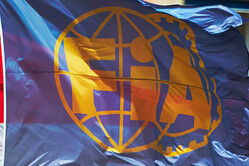


16/09/2014
NEWS STORY
 In reaction to the response from teams following last week’s directive on radio message restrictions the FIA has issued a follow-up directive.
In reaction to the response from teams following last week’s directive on radio message restrictions the FIA has issued a follow-up directive.
The initial directive was an attempt to prevent teams contravening Article 20.1 of the sporting regulations, which states that "the driver must drive the car alone and unaided”, since it was widely felt that is some cases the driver was merely the conduit by which the engineers and boffins were helping contro the car.
As teams expressed concern as to what information might and might not be passed on to drivers, leading to talk of coded messages, the FIA has issued a directive stating exactly what is and what isn't allowed.
Message types not allowed
Sector time detail of a competitor and where a competitor is faster or slower.
Adjustment of power unit settings.
Adjustment of power unit setting to de-rate the systems.
Adjustment of gearbox settings.
Learning of gears of the gearbox (will only be enforced from the Japanese Grand Prix onwards).
Balancing the SOC [state-of-charge of batteries] or adjusting for performance.
Information on fuel flow settings (except if requested to do so by race control).
Information on level of fuel saving needed.
Information on tyre pressures or temperatures (will only be enforced from the Japanese Grand Prix onwards).
Information on differential settings.
Start maps related to clutch position, for race start and pit stops.
Information on clutch maps or settings, e.g. bite point.
Burn-outs prior to race starts.
Information on brake balance or BBW (brake-by-wire) settings.
Warning on brake wear or temperatures (will only be enforced from the Japanese Grand Prix onwards).
Selection of driver default settings (other than in the case of a clearly identified problem with the car).
Answering a direct question from a driver, e.g. "Am I using the right torque map"?
Any message that appears to be coded.
Message types allowed
Acknowledgement that a driver message has been heard.
Lap or sector time detail.
Lap time detail of a competitor.
Gaps to a competitor during a practice session or race.
"Push hard", "push now", "you will be racing xx" or similar.
Helping with warning of traffic during a practice session or race.
Giving the gaps between cars in qualifying so as to better position the car for a clear lap.
Puncture warning.
Tyre choice at the next pit stop.
Number of laps a competitor has done on a set of tyres during a race.
Tyre specification of a competitor.
Indication of a potential problem with a competitor's car during a race.
Information concerning a competitors likely race strategy.
Yellow flags, blue flags, Safety Car deployment or other cautions.
Most of these bans are implemented from this weekend's Singapore Grand Prix, while those involving tyre and brakes will be implemented from Suzuka.
The ban on the imparting of technical information will also apply to pit boards.